Science Education and Artificial Intelligence – A Chatbot on Magic and Quantum Computing as an Educational Tool
Science Education and Artificial Intelligence – A Chatbot on Magic and Quantum Computing as an Educational Tool
Author(s): Miquel Duran, Sílvia Simon, Fernando BlascoSubject(s): Social Sciences, Education, Higher Education
Published by: European Distance and E-Learning Network
Keywords: STE(A)M Education; Artificial Intelligence;Open Learning and Education
Summary/Abstract: Artificial Intelligence (AI) has entered the realm of higher education and has become an impressive emerging field. Since AI is starting also to be applied to Science Education, we provide an assay and review and assess the opportunities of AI in a particular case of Science Education, namely a chatbot on Quantum Computing, another awesome emerging field. Indeed, Quantum Computing is based on a set of principles that are difficult to understand by the general population, so the ultimate goal of such a chatbot is to learn a few complex concepts in this field and to increase public understanding and awareness of Science. Actually, AI is starting also to be applied to Science Communication, even though progress is not so advanced as in learning. Developing a chatbot is not especially difficult (e.g., with Botpress, Watson, Dialogflow, Manybot, ...). One may build either scripted, intelligent, or application bots. Indeed, the first ones are those that are easiest to create, and correspond to the first phase of the current project. At every step the user is asked to click a button or select from a limited number of options. Intelligent bots understand natural spoken language and correspond to a second phase in our initiative. Blending of the first two bot types result into Application bots. In general, Bots are connected to a real-world messaging service, like Facebook Messenger, Twitter, Telegram, Slack, etc.
Journal: European Distance and E-Learning Network (EDEN) Conference Proceedings
- Issue Year: 2020
- Issue No: 1
- Page Range: 137-142
- Page Count: 6
- Language: English

